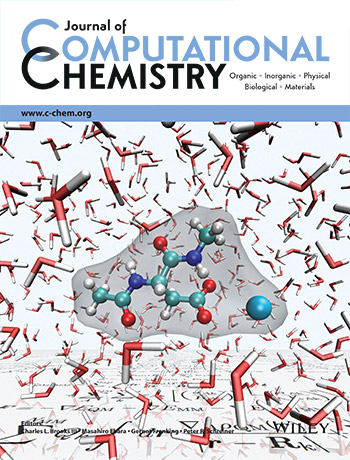
SDSC Team Develops Multi-scale Simulation Software for Chemistry Research
By:
- Jan Zverina
Published Date
By:
- Jan Zverina
Share This:
Article Content
Researchers at the San Diego Supercomputer Center at the University of California, San Diego, have developed software that greatly expands the types of multi-scale QM/MM (mixed quantum and molecular mechanical) simulations of complex chemical systems that scientists can use to design new drugs, better chemicals, or improved enzymes for biofuels production.
A paper outlining the research, titled ‘An Extensible Interface for QM/MM Molecular Dynamics Simulations with AMBER’, was featured on the cover of the January 15th issue of the Journal of Computational Chemistry.

The journal cover shows a calcium ion coordinating to aspartate, a model for proteins in aqueous solution used by the authors to demonstrate features of the software. The multi-scale QM/MM equations governing the implementation are visible on the surface that extends to the horizon.
Multi-scale QM/MM computational methods are crucial to advancing the understanding and solution to problems in the chemical sciences, ranging from drug design to renewable energies. This has been recognized with the award of the 2013 Nobel Prize in chemistry for the development of multi-scale models of complex chemical systems.
In QM/MM simulations, an accurate but computationally complex and thus time-consuming quantum mechanical model is used to identify important features of the electronic structure of a chemically relevant region. This is required, for example, to describe photo-physical processes or chemical reactions in the active site of enzymes. Effects of the surrounding environment are then included with a computationally less complex classical MM model.
“Our software enables QM/MM simulations with a variety of advanced quantum mechanical models, and by integrating it with the popular AMBER molecular simulation package, which is used by hundreds of academic and industrial research labs, we can reach a very large user base,” said lead author Andreas W. Goetz, a research scientist with SDSC and expert in multi-scale software modeling. “We’re looking forward to many exciting applications that will help scientists in computational chemistry and biophysics understand and predict the behavior of molecular systems at a fundamental level.”
Authors of the new study include SDSC's Goetz and Ross C. Walker, an SDSC research professor and adjunct associate professor in UC San Diego’s Department of Chemistry and Biochemistry; as well as Matthew A. Clark, who developed part of the software during his internship with Walker and Goetz, contributed to the research as part of SDSC’s Research Experience for High School Students (REHS) program and later as an undergraduate research intern.
Share This:
You May Also Like
Stay in the Know
Keep up with all the latest from UC San Diego. Subscribe to the newsletter today.


